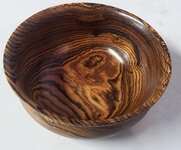As a wood worker all my life, I have to agree entirely with Philips comments...!
Now, as a wood seller of non-commercial woods and only those that grown around me and that I cut/salvage or process from the very start, I know well how temperamental some woods are, when you leave nature to do its thing when it comes to drying the wood.
Air drying has 2 sides to it, any wood that is left to dry naturally, will always be more stable than any other put through accelerated mechanic drying processes, unless the system used is radiation and wood bath treatment...!
Letting the wood dry naturally, will always allow cracks to develop and in many time, rip the wood to threads some beyond usable, unless one is only making pen blanks from it. The way the wood is cut/sliced/ripped for air dry "stacking", is the most determine factor to the amount of cracks distortion and other abnormalities, happening during that process.
As a wood seller, I try to remove most of the cracking's and other faults that I see will spoil the blank however, as a wood turner, I see each blank for its potential so I make them available as is so that other can make the selection based upon, to what they are comfortable to work with.
There are people out there that, would not accept ant blank with any cracks, knots, flaws or anything else that would not make it a "perfect" blank. For these people, perfect wood is totally flawless, and most of these come from very large trees milled in very large timber mills.
There is nothing wrong with wanting only flawless wood, if you are prepared to pay for its perfection but, a large % of wood turners want to pay very low prices for something that as taken a great deal of time, effort and waste to produce that perfect piece/blank, that unless you have experience with processing wood, you would never understand.
Now, are all woods the same...??? hell no...! some are quite easy to yield quality, quantity and sizes, others wouldn't yield anything bigger that to make a pen blank in diameter. Counting all the others in between, some woods are simply easy to work/process than others, some rarely develop cracks either green or dry while others, you look at them a little cross and they start cracking in front of your eyes...!
However, one thing is for certain, if you are charged premium prices for exhibition grade woods/blanks , you can expect top grade premium quality woods/blanks and if in some of those rarer woods where ownership, has little to do with the wood condition then, is up to each individual experience, ability (workmanship) to work that piece accordingly and produce a quality finish product.
In regards to blanks that are fully waxed (normally when green) and that cracks or flaws "contaminated" with way, boiling the wood or simply pouring boiling water over the waxed area, is in most cases sufficient to remove all the wax successfully...!
Fillings are indeed a great thing and is also up tom each individual to decide if a match or a contrast filling is more appropriate. Not all cracks and or flaws have to be filled or touched in any way, sometimes its natural look is what values the piece...! This maybe explain why some wood people deliberately carve/cut/create all sorts of flaws in the wood, from the lack of getting/obtaining any blanks with really natural flaws so they created their own...!
Either way, is fine...! just remember that some woods have a mind of their own and regardless what you do/want, they do their thing and you have absolutely no control over, period...!
Good luck and lets make some shavings...!
PS: Also remember that, nature produces the most colourful and intricate grain formations, around flaws...!:wink:
Cheers
George

